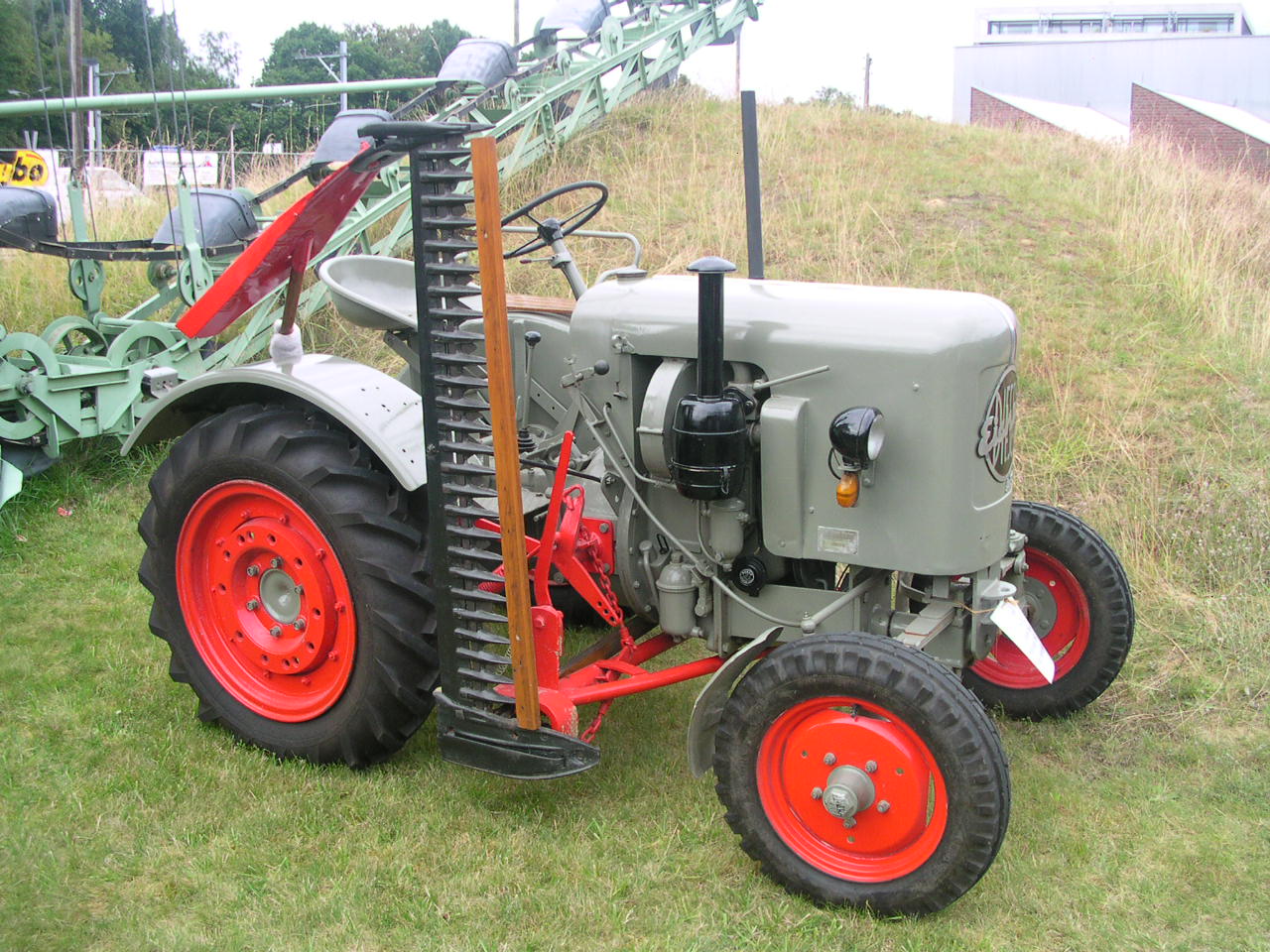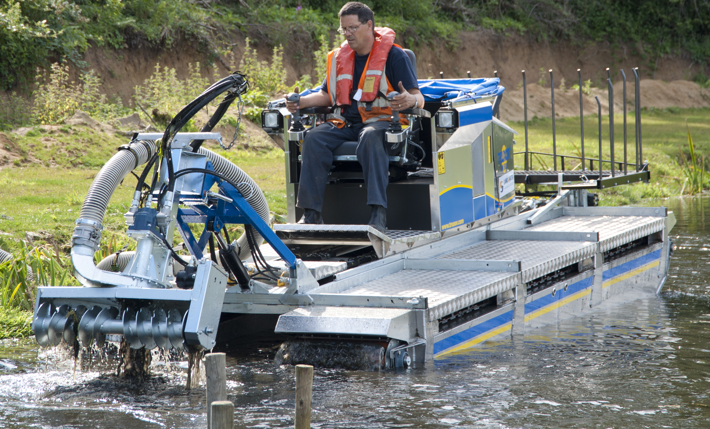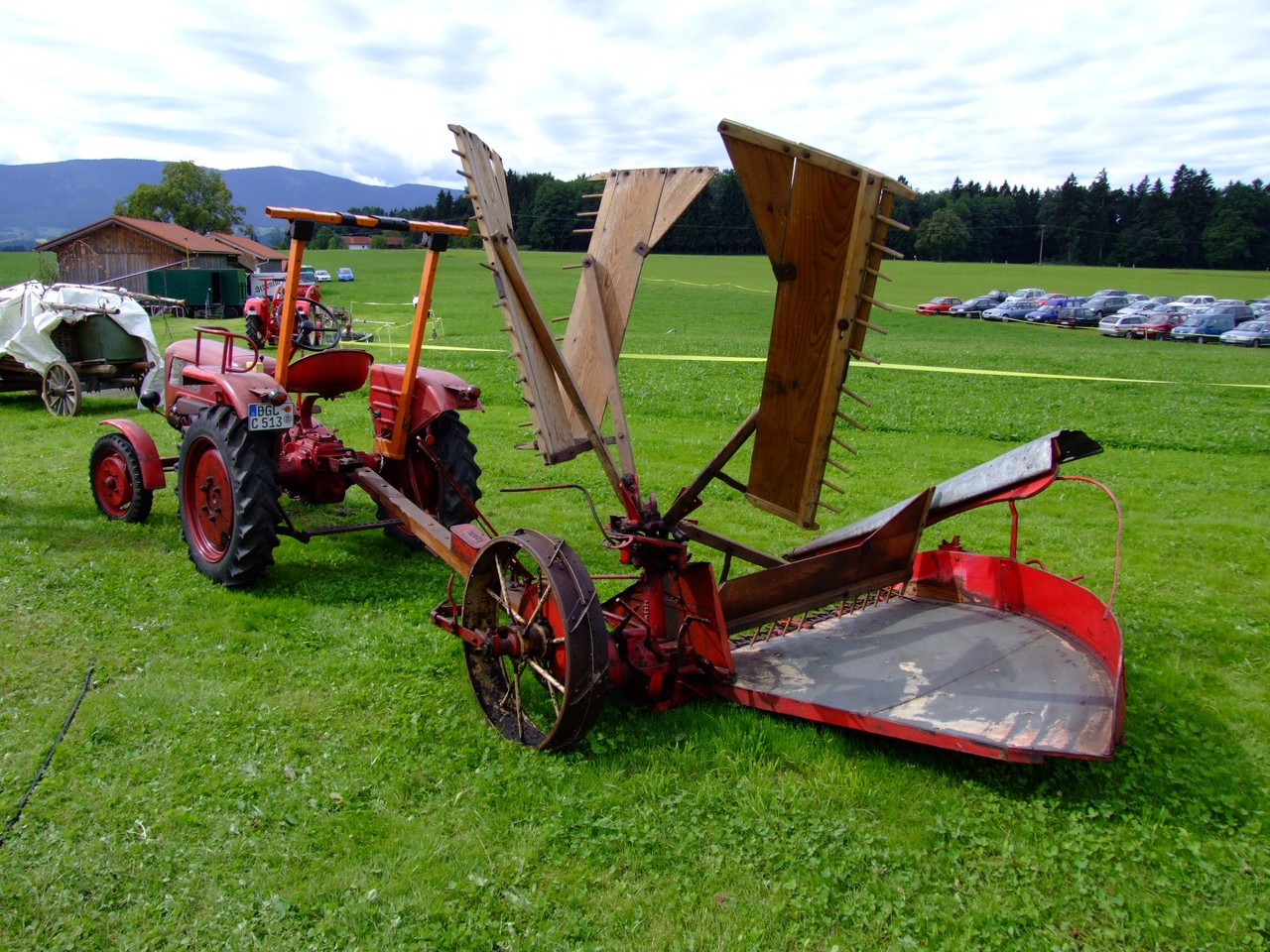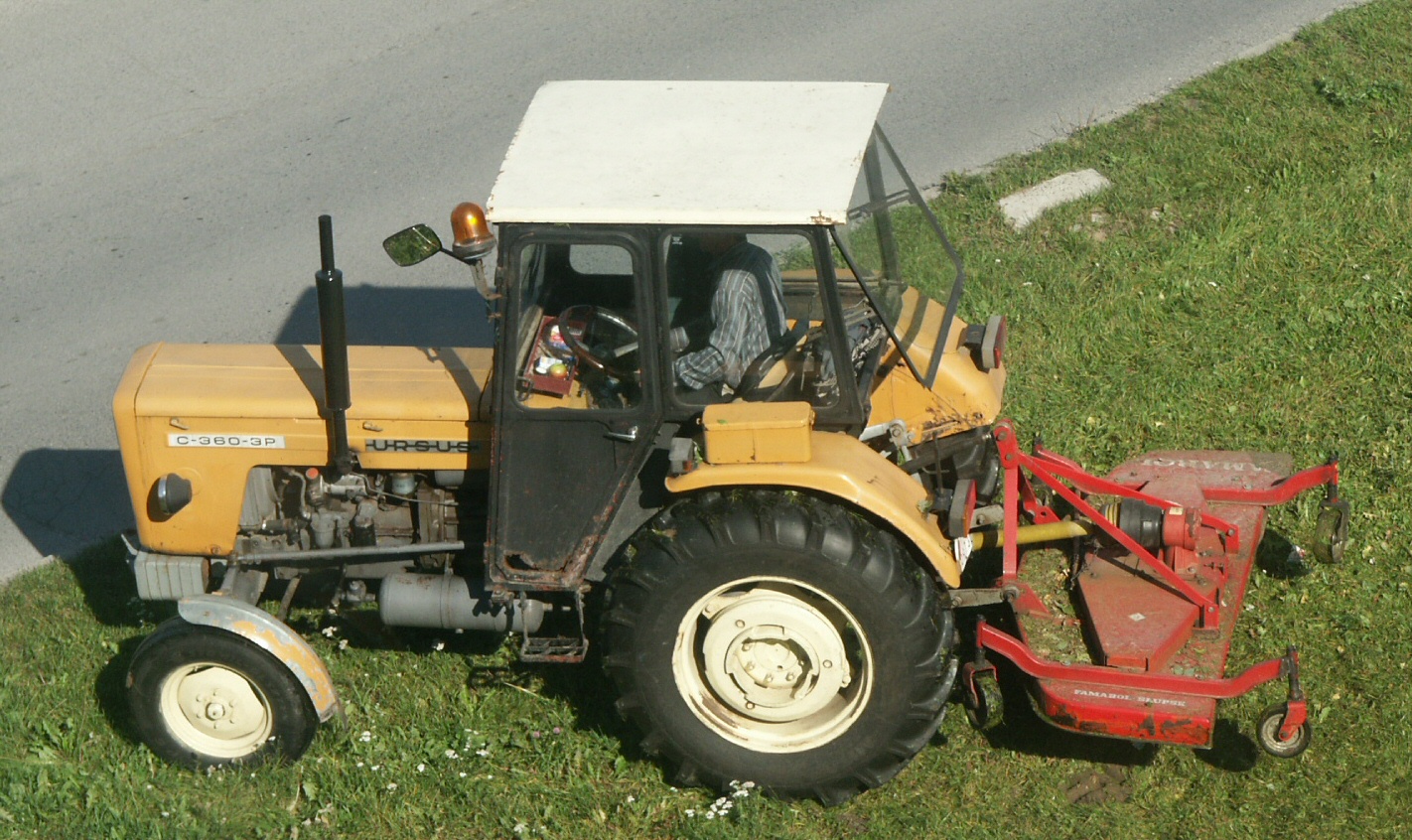|
Mowing
A mower is a person or machine that cuts (mows) grass or other plants that grow on the ground. Usually mowing is distinguished from reaping, which uses similar implements, but is the traditional term for harvesting grain crops, e.g. with reapers and combines. A smaller mower used for lawns and sports grounds (playing fields) is called a ''lawn mower'' or ''grounds mower'', which is often self-powered, or may also be small enough to be pushed by the operator. Grounds mowers have reel or rotary cutters. Larger mowers or '' mower-conditioners'' are mainly used to cut grass (or other crops) for hay or silage and often place the cut material into rows, which are referred to as ''windrows''. '' Swathers'' (or ''windrowers'') are also used to cut grass (and grain crops). Prior to the invention and adoption of mechanized mowers, (and today in places where use a mower is impractical or uneconomical), grass and grain crops were cut by hand using scythes or sickles. Mower configurations ... [...More Info...] [...Related Items...] OR: [Wikipedia] [Google] [Baidu] |
Scythe
A scythe ( ) is an agricultural hand tool for mowing grass or harvesting crops. It is historically used to cut down or reap edible grains, before the process of threshing. The scythe has been largely replaced by horse-drawn and then tractor machinery, but is still used in some areas of Europe and Asia. Reapers are bladed machines that automate the cutting of the scythe, and sometimes subsequent steps in preparing the grain or the straw or hay. The word "scythe" derives from Old English ''siðe''. In Middle English and later, it was usually spelt ''sithe'' or ''sythe''. However, in the 15th century some writers began to use the ''sc-'' spelling as they thought (wrongly) the word was related to the Latin ''scindere'' (meaning "to cut"). Nevertheless, the ''sithe'' spelling lingered and notably appears in Noah Webster's dictionaries. A scythe consists of a shaft about long called a ''snaith'', ''snath'', ''snathe'' or ''sned'', traditionally made of wood but now sometimes me ... [...More Info...] [...Related Items...] OR: [Wikipedia] [Google] [Baidu] |
Lawn Mower
A lawn mower (also known as a mower, grass cutter or lawnmower) is a device utilizing one or more revolving blades (or a reel) to cut a grass surface to an even height. The height of the cut grass may be fixed by the design of the mower, but generally is adjustable by the operator, typically by a single master lever, or by a lever or nut and bolt on each of the machine's wheels. The blades may be powered by manual force, with wheels mechanically connected to the cutting blades so that when the mower is pushed forward, the blades spin or the machine may have a battery-powered or plug-in electric motor. The most common self-contained power source for lawn mowers is a small (typically one cylinder) internal combustion engine. Smaller mowers often lack any form of propulsion, requiring human power to move over a surface; "walk-behind" mowers are self-propelled, requiring a human only to walk behind and guide them. Larger lawn mowers are usually either self-propelled "walk-behind" ... [...More Info...] [...Related Items...] OR: [Wikipedia] [Google] [Baidu] |
Reel Mower
A lawn mower (also known as a mower, grass cutter or lawnmower) is a device utilizing one or more revolving blades (or a reel) to cut a grass surface to an even height. The height of the cut grass may be fixed by the design of the mower, but generally is adjustable by the operator, typically by a single master lever, or by a lever or nut and bolt on each of the machine's wheels. The blades may be powered by manual force, with wheels mechanically connected to the cutting blades so that when the mower is pushed forward, the blades spin or the machine may have a battery-powered or plug-in electric motor. The most common self-contained power source for lawn mowers is a small (typically one cylinder) internal combustion engine. Smaller mowers often lack any form of propulsion, requiring human power to move over a surface; "walk-behind" mowers are self-propelled, requiring a human only to walk behind and guide them. Larger lawn mowers are usually either self-propelled "walk-behind" ... [...More Info...] [...Related Items...] OR: [Wikipedia] [Google] [Baidu] |
Groundskeeping
Groundskeeping is the activity of tending an area of land for aesthetic or functional purposes, typically in an institutional setting. It includes mowing grass, trimming hedges, pulling weeds, planting flowers, etc. The U.S. Department of Labor estimated that more than 900,000 workers are employed in the landscape maintenance and groundskeeping services industry in the United States in 2006. Of these over 300,000 workers were greenskeepers for golf courses, schools, resorts, and public parks. Compare gardener. Occupation A groundskeeper is a person who maintains landscaping, gardens or sporting venues (and their vegetation where appropriate) for appearance and functionality. In Britain the word ''groundsman'' (occasionally ''groundswoman'' if appropriate) or ''park-keeper'' is used much more commonly. The Football Association confers a Groundsman of the Year award. In Australia, the word ''curator'' is often used for a person undertaking this job, especially those involving cric ... [...More Info...] [...Related Items...] OR: [Wikipedia] [Google] [Baidu] |
Aquatic Weed Harvester
An aquatic weed harvester, also known as a water mower, mowing boat and weed cutting boat, is an aquatic machine specifically designed for inland watercourse management to cut and harvest underwater weeds, reeds and other aquatic plant life. The action of removing aquatic plant life in such a manner has been referred to as "aquatic harvesting". Overview Water is an important resource and in many countries, waterways are increasingly clogged by aquatic plant growth. This is particularly so in tropical countries where warmer water means the plants grow more quickly, and increasing run-off of fertilisers and effluent has exacerbated the problem. Irrigation ditches and pumps can become overgrown with vegetation, power station and factory water intakes can get blocked, boats can get hindered, fish stocks can be disrupted, and water moves more slowly, resulting in greater evapotranspiration and a greater risk of flooding. In some large irrigation projects in India, canals have become ... [...More Info...] [...Related Items...] OR: [Wikipedia] [Google] [Baidu] |
Reaper
A reaper is a agricultural machinery, farm implement or person that wikt:reap#Verb, reaps (cuts and often also gathers) crops at harvest when they are ripe. Usually the crop involved is a cereal grass. The first documented reaping machines were Gallic reapers that were used in Roman times in what would become modern-day France. The Gallic reaper involved a comb which collected the heads, with an operator knocking the grain into a box for later threshing. Most modern mechanical reapers cut Poaceae, grass; most also gather it, either by windrowing or picking it up. Modern machines that not only cut and gather the grass but also threshing, thresh its seeds (the grain), winnowing, winnow the grain, and deliver it to a truck or wagon, called combine harvesters or simply combines, which are the engineering descendants of earlier reapers. Hay is harvested somewhat differently from grain; in modern haymaking, the machine that cuts the grass is called a hay mower or, if integrated wit ... [...More Info...] [...Related Items...] OR: [Wikipedia] [Google] [Baidu] |
Three-point Hitch
The three-point hitch (British English: three-point linkage) is a widely used type of hitch for attaching ploughs and other implements to an agricultural or industrial tractor. The three points resemble either a triangle, or the letter A. Three-point attachment is the simplest and the only statically determinate way of joining two bodies in engineering. A three-point hitch attaches the implement to the tractor so that the orientation of the implement is fixed with respect to the tractor and the arm position of the hitch. The tractor carries some or all of the weight of the implement. The other main mechanism for attaching a load is through a drawbar, a single point, pivoting attachment where the implement or trailer is not in a fixed position with respect to the tractor. The primary benefit of the three-point hitch system is to transfer the weight and resistance of an implement to the drive wheels of the tractor. This gives the tractor more usable traction than it would otherw ... [...More Info...] [...Related Items...] OR: [Wikipedia] [Google] [Baidu] |
Swather
A swather (North America), or windrower (Australia and rest of world), is a farm implement that cuts hay or small grain crops and forms them into a windrow for drying. They may be self-propelled with an engine, or drawn by a tractor and power take-off powered. A swather uses a reciprocating sickle bar or rotating discs to sever the crop stems. The reel helps cut crop fall neatly onto a canvas or auger conveyor which deposits it into a windrow with stems aligned and supported above the ground by the stubble. A swather does the same task for hay crops as hand scything, cradling and swathing, or mowing and raking. Horizontal rollers behind the cutters may be used to crimp or condition the stems of hay crops to decrease drying time. For grains, as combines replaced threshing machines, the swather introduced an optional step in the harvesting process to provide for the drying time that binding formerly afforded. Swathing is still more common in the northern United States ... [...More Info...] [...Related Items...] OR: [Wikipedia] [Google] [Baidu] |
Windrow
A windrow is a row of cut (mown) hay or small grain crop. It is allowed to dry before being baled, combined, or rolled. For hay, the windrow is often formed by a hay rake, which rakes hay that has been cut by a mowing machine or by scythe into a row, or it may naturally form as the hay is mown. For small grain crops which are to be harvested, the windrow is formed by a swather which both cuts the crop and forms the windrow. By analogy, the term may also be applied to a row of any other material such as snow, earth or materials for collection. * Snow windrows are created by snow plows when clearing roads of snow; where this blocks driveways the windrow may require removal. Snow windrowed to the centre of the street can be removed by a snow blower and truck. In preparing a pond or lake for ice cutting, the snow on top of the ice, which slows freezing, might be scraped off and windrowed. * Earth windrows may be formed by graders when grading earthworks or dirt roads * Leaf windr ... [...More Info...] [...Related Items...] OR: [Wikipedia] [Google] [Baidu] |
Conditioner (farming)
A conditioner (or ''hay conditioner'') is a farm implement that crimps and crushes newly cut hay to promote faster and more even drying. Drying the hay efficiently is most important for first cutting of the hay crop, which consists of coarse stalks that take a longer period of time to draw out moisture than finer-textured hays, such as second and subsequent cuttings. A conditioner is made up of two grooved rollers which the hay is forced through, causing the stalks to split, thus allowing the liquid trapped behind cell walls (sap and cell sap) to leak out and also giving more surface area for evaporation. The stand-alone conditioner is no longer used on most farms, since the conditioner has been incorporated into mower-conditioners, which combine the mower and conditioner into a single machine. The names Haybine and Discbine are brand names of mower-conditioners, although some farmers use these names somewhat generically. Mower-conditioners Mower-conditioners are a staple of lar ... [...More Info...] [...Related Items...] OR: [Wikipedia] [Google] [Baidu] |
Robot Mower Helps Flood Defence - Robot Torri Gwair Yn Helpu Amddiffyn Rhag Llifogydd
A robot is a machine—especially one programmable by a computer—capable of carrying out a complex series of actions automatically. A robot can be guided by an external control device, or the control may be embedded within. Robots may be constructed to evoke human form, but most robots are task-performing machines, designed with an emphasis on stark functionality, rather than expressive aesthetics. Robots can be autonomous or semi-autonomous and range from humanoids such as Honda's ''Advanced Step in Innovative Mobility'' ( ASIMO) and TOSY's ''TOSY Ping Pong Playing Robot'' (TOPIO) to industrial robots, medical operating robots, patient assist robots, dog therapy robots, collectively programmed ''swarm'' robots, UAV drones such as General Atomics MQ-1 Predator, and even microscopic nano robots. By mimicking a lifelike appearance or automating movements, a robot may convey a sense of intelligence or thought of its own. Autonomous things are expected to proliferate in ... [...More Info...] [...Related Items...] OR: [Wikipedia] [Google] [Baidu] |
Tractor
A tractor is an engineering vehicle specifically designed to deliver a high tractive effort (or torque) at slow speeds, for the purposes of hauling a trailer or machinery such as that used in agriculture, mining or construction. Most commonly, the term is used to describe a farm vehicle that provides the power and traction to mechanize agricultural tasks, especially (and originally) tillage, and now many more. Agricultural implements may be towed behind or mounted on the tractor, and the tractor may also provide a source of power if the implement is mechanised. Etymology The word ''tractor'' was taken from Latin, being the agent noun of ''trahere'' "to pull". The first recorded use of the word meaning "an engine or vehicle for pulling wagons or plows" occurred in 1896, from the earlier term " traction motor" (1859). National variations In the UK, Ireland, Australia, India, Spain, Argentina, Slovenia, Serbia, Croatia, the Netherlands, and Germany, the word "tractor" u ... [...More Info...] [...Related Items...] OR: [Wikipedia] [Google] [Baidu] |









